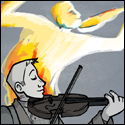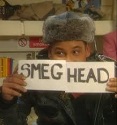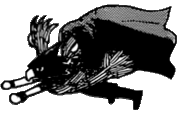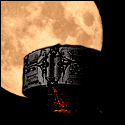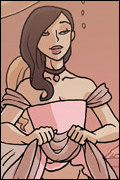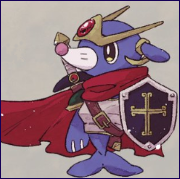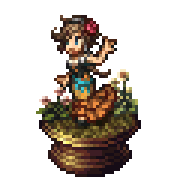|
In theory the minions' presence forces the controller to decide whether to place an AOE on them or use a better ability on a stronger enemy. In practice for that to happen there needs to be a slight power difference between AOEs and other controller abilities, and the enemies need to be placed in a way that forces a decision, and a hundred other strategic things the game never points out to either players or designers. I like the idea of controllers, I like the idea of combining controller and leader abilities to set up massive power strikes with almost guaranteed hits, but I see the point about invalidating monsters completely, and maybe "control" should mean "positioning" more than "status effects". There's also a problem in how classes like the Bard already do half their Leading through powers that put a condition on enemies, I think leader and controller should be defined by a much stricter split between "powers affect allies" and "powers affect enemies."
|
|
|
|

|
| # ? May 15, 2024 12:51 |
|
i can't seriously disagree with any of the criticisms about controllers' place in the game but at the same timeGort posted:If the opposition is permanently stunned, or taking a -10 to all actions and can't successfully use a power, it removes half the point of the encounter. doing this is basically my favorite thing in the world
|
|
|
|
Gort posted:Yeah, I don't really like the controller concept at all. Like, to me, the point of a 4e D&D fight is to have a cool and weird opponent show up, do it's cool and weird powers, then the heroes do their cool stuff and defeat it, all on some interesting terrain.
|
|
|
|
It's funny in a way, because I don't really have a problem with, "The barbarian killed the monster, so it didn't get to take a turn" or "the monster hit someone and then the warlord healed the person it hit back up" even though those are both functionally the same as the monster not getting a turn 'cause it's stunned or otherwise disabled.
|
|
|
|
Gort posted:It's funny in a way, because I don't really have a problem with, "The barbarian killed the monster, so it didn't get to take a turn" or "the monster hit someone and then the warlord healed the person it hit back up" even though those are both functionally the same as the monster not getting a turn 'cause it's stunned or otherwise disabled. The psion can give a small burst of enemies a -Lots penalty to all attack rolls without any effort at all. Killing a monster is a lot harder.
|
|
|
|
That sounds more like the balancing of the psion being suspect rather than the whole concept of the controller role being flawed though. I just meant to say that it feels worse to me as a GM to have the monsters be made useless than it does to have their consequences cured after they do them, or for them to be cut down by massive damage numbers, even if each of these three ways of beating monsters are doing an equal amount of work of defeating the monsters.
|
|
|
|
Gort posted:Area auto-damage powers, in particular, make me feel as a DM, "Why did I even bother putting these guys on the map". I generally feel that you should at least need to hit one of their defenses to defeat a minion, otherwise why even bother putting them in an encounter. I may be wrong but doesn't the wording of minions make them immune to auto-damage powers? If memory serves it's something like "any attack that hits a minion defeats it", so no attack roll, no dead minion.
|
|
|
|
Whybird posted:I may be wrong but doesn't the wording of minions make them immune to auto-damage powers? If memory serves it's something like "any attack that hits a minion defeats it", so no attack roll, no dead minion. Nah, it's "a missed attack never damages a minion", so if you have an attack that does half damage on a miss it doesn't take them out, but "take 3 damage"-type powers take them out with no roll.
|
|
|
|
Gort posted:It's funny in a way, because I don't really have a problem with, "The barbarian killed the monster, so it didn't get to take a turn" or "the monster hit someone and then the warlord healed the person it hit back up" even though those are both functionally the same as the monster not getting a turn 'cause it's stunned or otherwise disabled. If something's locked died I need to do the admin work to manage it - but it's going to be an excercise in frustration. If it's dead it's back in the box and there's no overhead. Gort posted:Speaking of controllers and minions, minions are all over the place in terms of their relative power. It feels like more thought needed to be put into exactly how killable a party should find them. By the rules, they're meant to be worth a quarter of a standard monster each, but depending on the party or the exact rules for the minion, they can be worth a lot less than that. Most of the minions in Monster Vault who don't have an on-death power have something to protect them from AoEs - such as the kobolds getting a free shift 2 1/encounter if they have the misfortune of ending in one.
|
|
|
|
Devorum posted:My current group has only ever payed 5E, and the current DM saw a bunch of YouTube videos about 4E and asked if I would run it for them since I've actually played it before. There are some obscure classes hidden in the Essentials books that aren't very good, but in general there's no downside to opening up the selection to all books. PHB1 and PHB2 classes are all very good and had the most stuff written for them. 4E is very very combat-centric and the fights can run a little long, especially in inexperienced groups. You should be prepared to only run 2-3 fights in one night, possibly less. As far as deeper dive stuff: In advanced play controllers are a flatly unnecessary role (as opposed to defender and leader, without which a party can't function), and in any situation, always best in a group that already has everything else covered. The very top-tier controller options do obviate most fights, which is amusing the first time it happens but quickly becomes the Worst. Almost every class can minor in some control options/minion slaughtering options. Minions are generally overcosted in encounter balancing in rules-as-written against experienced groups whether or not there is a controller. They do too little damage.
|
|
|
|
(Reading the posts about minion pinging has made me wonder what the Wizard would look like if Magic Missile was a class feature that worked like Flurry of Blows to allow the wizard to harass secondary targets or clear up minions while focusing the same target as the rest of the party is on.) The Warlock ended up with plenty of control while still regularly advancing the same clock-to-win as other classes by dealing damage. When my table has talked about the role, we've sort of imagined two avenues which might make control seem more distinctive: A.) Clearly signal *which* enemy is being controlled, like a mark or warlock's curse does. Limit (or center) the controller's power to the specified enemy. ("Enemies adjacent to this guy take damage" or "this guy can't make OAs"). This lets you keep the nasty penalties, interrupts, and stuns while preventing AOE lockdown, and clearly communicates to other players what the controller is contributing ("I'll deal with this guy so you can move freely/focus on other targets.") Possibly incentivize that division of labor by having the stronger control (stuns, etc.) fall off if the other PCs attack the stunned guy. B.) Work out from the druid variant that drops a Zone as a class feature. The controller has a somewhat-mobile Zone and only exerts strong control on enemies inside it. Encourages the player to interact with the map to create chokepoints, etc. and lets other players collaborate with control by using their forced movement to put enemies in the death box. Any sort of "reactive" or situational control (a power which is clearly intended to move an enemy away from a vulnerable ally, for example) should probably do something on a miss or with the effect line, as some sort of consolation prize - you hold a power in reserve until it helps, so it ought to help a bit even if it doesn't hit (as compared to a damaging striker power which is deployed more proactively.) The revision to the core Wizard powers to add Miss effects, sadly, didn't feel like a conscious effort to do this - just getting fireball to be "save for half damage" again.
|
|
|
|
neonchameleon posted:Most of the minions in Monster Vault who don't have an on-death power have something to protect them from AoEs - such as the kobolds getting a free shift 2 1/encounter if they have the misfortune of ending in one. I think you might be misremembering that one, there's only two minions in the Monster Vault with "get out of AOE" interrupts (kobold tunneler and troglodyte grunt) and the vast majority of minions don't have either that or an on-death power.
|
|
|
|
Sodomy Hussein posted:4E is very very combat-centric and the fights can run a little long, especially in inexperienced groups. You should be prepared to only run 2-3 fights in one night, possibly less. The flipside of this is that if you're running a narrative-led game, every combat should be a major event. If you can remove a combat without affecting the plot, do so. Equally, make sure there are several things going on in any one fight. Secondary objectives, ways in which the battlefield changes, terrain that does interesting things, and so on. Both of the campaigns I've run have been narrative-heavy enough that there has only been one or two combat encounters per day. 4e is balanced on the assumption that you are going to have two or three times as many as that. The workaround I've found is to only have daily abilities recover on an extended rest. An extended rest is defined to be a period of time where the party rest and relax in a place of safety -- but crucially, one that takes long enough that their enemies are able to advance their plans. So if you're racing someone to get to an ancient treasure in a forgotten tomb, if you take an extended rest on the way then when you arrive they'll have already got there and animated the tomb's inhabitants as skeletons under their service -- or if you take multiple rests, you might miss them altogether (but still get a clue on where they're heading next).
|
|
|
|
Whybird posted:The flipside of this is that if you're running a narrative-led game, every combat should be a major event. If you can remove a combat without affecting the plot, do so. Equally, make sure there are several things going on in any one fight. Secondary objectives, ways in which the battlefield changes, terrain that does interesting things, and so on. Yeah I agree with this in particular. What I had to say about it in August: quote:4E moves away from ticky-tack encounters you can resolve in 5 minutes and do on the fly. Regardless of what us 4E people say, 4E is not a great game on the fly. What it does do is ask you the DM to have involved, at least fairly well-planned encounters that are balanced to be challenging and not "the table says 2d6 goblins appear." 4E is also terrible without significant terrain details; if you play it lazily on a flat plane it just doesn't work, that will actually break certain characters' builds.
|
|
|
|
Hey, I'm running a 4e Campaign, and am looking for players, what's good?! I'm available pretty much 24/7 so I'm going to be real flexible with the schedule. https://forums.somethingawful.com/showthread.php?s=&threadid=3948397
|
|
|
|
Hello, I hear that someone in here can direct me to a Zeitgeist package for the offline character builder. Anyone know where I can find it?
|
|
|
|
potatocubed posted:Hello, I hear that someone in here can direct me to a Zeitgeist package for the offline character builder. Anyone know where I can find it?  It's not mine, but it's at least a starting point.
|
|
|
|
Also I can point you in the right direction for Fantasy Grounds conversion of the 4e zeitgeist.
|
|
|
|
I'm not even sure what books to buy for the 4e Zeitgeist. It looks really cool.
|
|
|
|
Halloween Jack posted:I'm not even sure what books to buy for the 4e Zeitgeist. It looks really cool. I think seriously all you need is the offline builder and a sense of the rules - the rules compendium or something. It doesn't use magic items or monsters from any of the core books; it's completely self-contained. (You will want to use inherent bonuses, more than likely. But even if you are like, "wow, we need more magic items" the builder has those too.)
|
|
|
|
Any advice for a first time DM looking to run 4E for a bunch of new players? I’ve never played a system with this kind of tactical combat, does anyone know of any good actual plays so I can see how it looks in practice?
|
|
|
|
I make this post every few months, but I actually have played a 4E game riddled with short, easy "popcorn" combats (the DM was just doing a 1-to-1 translation of some 3E megadungeon module) and it was actually really fun. You'd open a door and see two goblins or whatever and mop them up easily, but it gave you the opportunity to make some basic positioning/power deployment decisions and each was an optimization challenge to see if you could splatter the enemies before they managed to actually hit you - because, after all, any damage you took was ultimately going to come out of your healing surges and thus carry over to the rest of the day. Basically, it's a mistake to think that 4E needs to have nothing but complicated setpiece battles. Rather, 4E is the only edition which can produce engaging complicated setpiece battles (rather than save or die rocket tag or whatever), but it's still perfectly fine running more generic and less ambitious D&D.
|
|
|
|
Ferrinus posted:I make this post every few months, but I actually have played a 4E game riddled with short, easy "popcorn" combats (the DM was just doing a 1-to-1 translation of some 3E megadungeon module) and it was actually really fun. You'd open a door and see two goblins or whatever and mop them up easily, but it gave you the opportunity to make some basic positioning/power deployment decisions and each was an optimization challenge to see if you could splatter the enemies before they managed to actually hit you - because, after all, any damage you took was ultimately going to come out of your healing surges and thus carry over to the rest of the day.
|
|
|
|
I disagree - being able to open up with what were effectively our signature moves on a regular basis was fun (I had a warforged barbarian with that level 1 encounter attack that did a ton of damage but gave you -4 AC until your next turn, which I described as a big telegraphed boss attack that revealed my character's glowing red weak spot), and encounter attacks can miss the same as at-will attacks. Also, we were pretty low level, so sometimes the one or two encounter powers once of us was packing were actually less appropriate than a particular at-will because of how the enemies were grouped or what kind of hazards were on the map to push things into or whatever. If you effectively reduce the players' control or damage output at the same time as you reduce the monster count you'd certainly be making less complicated fights but not necessarily shorter ones.
|
|
|
|
Scrap Dragon posted:Any advice for a first time DM looking to run 4E for a bunch of new players? I’ve never played a system with this kind of tactical combat, does anyone know of any good actual plays so I can see how it looks in practice? Unfortunately, 4e ended before the golden age of actual plays with video.
|
|
|
|
I do have a shitton of beginner DM advice in my post history, but it's buried in seven pages of shitposting.
|
|
|
|
Scrap Dragon posted:Any advice for a first time DM looking to run 4E for a bunch of new players? I’ve never played a system with this kind of tactical combat This sort of tactical combat demands that both the players and the GMs actually learn the options they have available to them. The biggest advice I can give you is make sure everyone at the table is comfortable with this fact and fully engaged with the mechanical parts of the game, and not just reading a book or playing a video game when it's not their turn and only occasionally looking up when their name is called. Otherwise, fights will be confusing, frustrating, and take forever. The second biggest piece of advice I can give you is to use the MM3 maths for all your monster stat blocks. Also, 4E is improved on a mechanical level by applying the maths fixes and inherent bonuses, but feel free to ignore those for your first several sessions - running things RAW will work out alright at lower levels and you won't need to get lost cross-referencing two books and a spreadsheet if you just go by what PHB1/RC say.
|
|
|
|
Scrap Dragon posted:Any advice for a first time DM looking to run 4E for a bunch of new players? I’ve never played a system with this kind of tactical combat, does anyone know of any good actual plays so I can see how it looks in practice? - Terrain is extremely important. Use difficult terrain, use areas that trigger effects when someone enters (or is pushed) into them, have maps that change when some condition is met, etc. - When possible, start players in the middle of the battle map and give them plausible reasons to at least potentially go in different directions. - Closely related, maps don't have to be huge, but they should at least usually be big enough that it takes a couple of turns to get from one end to the other. - Technically just following the rules as-written will cover this, but don't have all the monsters (or all the players) act at once. The players should have time to respond to setbacks and one side getting too many actions in a row undermines this. - The system is pretty robust. Once your players have a baseline level of familiarity with the system, you can play team monster intelligently -- push the players, use the options available to you, try to "win." In the long run this makes for a much more satisfying experience because the challenge isn't just a narrative conceit, it's something actually present in the game. - Conversely, when designing encounters, be a fan of the party. Don't be afraid to set up enemies that are vulnerable to the players' strengths. Create situations where they get to shine, where they have the solution to the problem in front of them and just have to apply it correctly. Make them think -- even better is if they see two great opportunities and have to choose between them -- and encourage them to rely on each other for the things they can't do. - Use the MM3 or the "MM3 on a business card", the early monster math makes for long, boring fights. Tuxedo Catfish fucked around with this message at 05:26 on Dec 17, 2020 |
|
|
|
I just watched a video about non 4e D&D where a person effectively proposed using ‘minions’, and they took what I thought was a surprising stance on it. So, let me ask here, a place which will know a lot about ‘minions’, When you use minions is it better for the players to know that they only have 1 hit or to obscure that information?
|
|
|
|
DalaranJ posted:I just watched a video about non 4e D&D where a person effectively proposed using ‘minions’, and they took what I thought was a surprising stance on it. So, let me ask here, a place which will know a lot about ‘minions’, In-game, it is probably obvious to the heroes that they are facing chumps. Out-of-game, it would be a horrible play experience to blow a big move on a thing that drops to any hit.
|
|
|
|
Yeah while I won't say there's a wrong way to play if everyone knows in advance any event can be a minion and thinks that's cool, but I would definitely be annoyed for the above reasons
|
|
|
|
DalaranJ posted:I just watched a video about non 4e D&D where a person effectively proposed using ‘minions’, and they took what I thought was a surprising stance on it. So, let me ask here, a place which will know a lot about ‘minions’, If you're not going to tell your players what is and isn't a minion (which you should, because blowing encounters/dailies on minions sucks), the information should be telegraphed in some way (making them uniform in their token/mini design) to give your players some intuition room to figure it out.
|
|
|
|
I've also used, like... super-minions that take two hits to kill, or one hit that's particularly beefy. Then it's not as important if you don't tell the players they're minions, but it's still kind of a dick move.
|
|
|
|
PMush Perfect posted:I've also used, like... super-minions that take two hits to kill, or one hit that's particularly beefy. Then it's not as important if you don't tell the players they're minions, but it's still kind of a dick move. Two-hit kill (unless you hit a threshold) is one workable one. Minions that give bonuses to their buddies is another (like, I had one that gave +2 to all defenses for adjacent allies, with infinite stacking, for a puzzle combat of sorts). Minions that do something bad on death are always fun, too. Oh, and infinite spawners of course. If nothing else, you should telegraph what's going on in-game by flavor. It's just bad GMing to describe minions as crazy badasses or as notable. And yes, the fact that all the minions use little minion icons and come in batches of 4 is another good sign.
|
|
|
|
DalaranJ posted:I just watched a video about non 4e D&D where a person effectively proposed using ‘minions’, and they took what I thought was a surprising stance on it. So, let me ask here, a place which will know a lot about ‘minions’, Arrrthritis posted:If you're not going to tell your players what is and isn't a minion (which you should, because blowing encounters/dailies on minions sucks), the information should be telegraphed in some way (making them uniform in their token/mini design) to give your players some intuition room to figure it out.
|
|
|
|
dwarf74 posted:100% you should let your players know. Yes, that was my take as well. Shocking that D&D youtube videos could contain bad opinions. Anyway, I'm glad I was at reminded that minions are an option, because they're a good one.
|
|
|
|
DalaranJ posted:When you use minions is it better for the players to know that they only have 1 hit or to obscure that information? 99% of the time you let the players know that "You're experienced adventurers. These guys are not in your league at all but there are a lot of them." or the like. Reading who's a real threat should be part of the assumed skills of an adventurer. Very occasionally a named NPC can be a minion for comedy or dramatic purposes. Learned sage NPCs who look about 100 years old are sometimes extremely good at not dying while others are one stiff breeze from falling over. Also there are some NPCs who are bullies but fold like a cheap tent when really pressured. It's worth knowing about, but this is not the default case.
|
|
|
|
Tuxedo Catfish posted:- Terrain is extremely important. Use difficult terrain, use areas that trigger effects when someone enters (or is pushed) into them, have maps that change when some condition is met, etc. This. Also it doesn't have to be wonderous and fantastical terrain. I've sold a group on 4e just by having the first fight be near the latrine and making sure all the PCs had forced movement abilities. Most of my towns have open sewers again to push someone into. And fights on the harbour docks mixed with PCs with forced movement normally have people going swimming. Also at the more epic scale work out in advance what will happen when someone pushes the NPC through their own summoning portal - because a smart group that's realised how much fun forced movement can be will do this. Even just an ambush at night should have attempts to push people into the camp fire. (Also remember the NPCs should sometimes get to try to do this to the PCs). I've said repeatedly that after 4e any other RPG using a battle map feels like acting against a green screen. Meanwhile in 4e if you're fighting on a second floor walkway with no or a weak handrail and have watched any Hong Kong martial arts films you know what to do. (Forced movement is such a thing in 4e because although other D&Ds have bull rush abilities 4e gives forced movement out as something a lot of characters can use as part of rather than instead of their attacks). quote:- The system is pretty robust. Once your players have a baseline level of familiarity with the system, you can play team monster intelligently -- push the players, use the options available to you, try to "win." In the long run this makes for a much more satisfying experience because the challenge isn't just a narrative conceit, it's something actually present in the game. The PCs are also generally tougher than either you or (especially) they think most of the time. Between leader healing, dailies, and second winds, the game is set up to make the players feel that they are going to lose when the odds are actually in their favour. quote:- Use the MM3 or the "MM3 on a business card", the early monster math makes for long, boring fights.  The "good" monster manuals are the Monster Manual 3, the Dark Sun Creature Catalog, Monster Vault (which is effectively a Monster Manual replacement), and Monster Vault: Threats to the Nentir Vale. Also: Skill challenge rules are useful but the way they are explained is just bad. They're a great improv tool, but the officially published examples are generally like watching a good improv comedian, writing down one of their shows, and saying "do that" even if the tool itself is what the comedian uses. If you're an experienced GM you don't need them. Combat is desert not the main course. Too much combat is ... too much and 4e doesn't really do small incidental fights. Build to big fights. And don't worry if the PCs go off in a random direction; shopping from the monster manual based on their level and drawing a few interesting piece of terrain on the spur of the moment will be as engaging as that massive setpiece that took you half a dozen hours to prepare in any other edition. Also specifically on combat design: Don't use blanket terrain that halves everyone's speed (which also means most can't shift). Combat thrives on mobility. And mix your monster types; just artillery or just brutes is fairly boring. Brutes and artillery so you want to lock down the brutes and melee the artillery; you're trying to move past one to get the other. That's instantly far more interesting than handling them all the same way.
|
|
|
|
I would actually limit my list of good monster manuals to the Vaults and nothing else. MM3 and DSCS use fixed math but not fixed design philosophy.
|
|
|
|

|
| # ? May 15, 2024 12:51 |
|
dwarf74 posted:I would actually limit my list of good monster manuals to the Vaults and nothing else. MM3 and DSCS use fixed math but not fixed design philosophy. I suspect that this is a disagreement about where we set the bar. MV and MV:TttNV are probably the two best monster manuals in any edition of D&D and adjacent games ever (and I really wish they'd done more with the NV format even in 5e). The MM3 and DSCS aren't quite as good or as reliable - but getting there.
|
|
|










